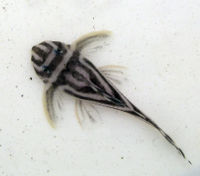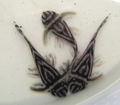Difference between revisions of "Hypancistrus zebra"
From The Aquarium Wiki
(→External links) |
|||
| Line 90: | Line 90: | ||
*{{FishBase |id=53570}} | *{{FishBase |id=53570}} | ||
*[http://www.planetcatfish.com/common/species.php?species_id=168 Planet Catfish] | *[http://www.planetcatfish.com/common/species.php?species_id=168 Planet Catfish] | ||
| + | *[https://connectfishfriends.com/livestock-details/zebra-pleco Connect Fish Friends] | ||
Latest revision as of 02:39, 26 October 2023
Zebra Pleco
Hypancistrus zebra
57 Litres (15 US G.)
6.4-7.6cm (2.5-3 ")
Freshwater
6.0 - 7.5
26 -30 °C (78.8-86°F)
8-18 °d
1:1 M:F
3-5 years
Family
Loricariidae
This animal is available captive bred
Contents
Additional names
- Zebra Pleco, Imperial Pleco, L046, L098, L173
Sexing[edit]
- The first pectoral fin ray of the male is thicker than that of the female. Males in breeding condition further develop their spine-like odontodes on this ray. The male has a slightly broader head than the female, best observed from above.
Tank compatibility[edit]
- Best kept in a breeding group in a species tank. Is generally a peaceful Pleco. Males may act territorial towards one another.
Diet[edit]
- A primarily herbivorous fish, feed algae wafers and blanched vegetables. Young Zebras may also take, and benefit from, baby brine shrimp.
Feeding regime[edit]
- Feed once or twice a day.
Environment specifics[edit]
- Require a spacious tank with sand substrate and caves in which to breed. A mature, well filtered tank is essential.
Behaviour[edit]
- A peaceful shy Pleco.
Identification[edit]
- An exceptionally striking and desirable Pleco, it has a white base colour with many black bands running down the body. This is a rare fish and there are other stripy Plecos that may get mislabelled as a Zebra. The black bands on this fish run as follows, on the head there is a vertical band running around the head which encompasses the eye, there are a several diagonal bands running from this to the end of the nose. Behind the gills there is another thick black band that runs from the tip of one pectoral fin right across and over the body to the other side. From this band there are a number of horizontal black bands running down the body and through the dorsal and caudal fins. The pelvic fins have fuzzy black and white markings.
- There is a Hypancistrus sp., or L173, pattern variation that is not seen very often where the horizontal bands running down the body are wavy rather than straight and there are more vertical bands than horizontal. As it matures it's slightly more stocky and the body is higher than the Hypancistrus zebra. It may be that this is a separate species to the Hypancistrus zebra but not much is known about it.
Species Note[edit]
- This fish commands a high price tag from both breeders and the few aquatic stores that are able to get hold of them. They were banned from export from their native South America which has led to their increased desirability in Pleco-keeping circles. They do breed well in captivity in the right conditions so captive bred fish are available occasionally, they will usually set you back around £250 or equivalent however.
Pictures[edit]
Videos[edit]
External links[edit]
- Fishbase (Mirrors:
 )
)



